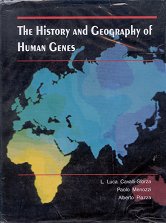The authors reconstruct the history of our evolution by focusing on genetic divergence among human groups. Using genetic information accumulated over the last fifty years, they examined over 110 different inherited traits, such as blood types, HLA factors, proteins, and DNA markers, in over eighteen hundred, primarily aboriginal, populations. By mapping the worldwide geographic distribution of the genes, the scientists are now able to chart migrations and, in exploring genetic distance, devise a clock by which to date evolutionary history: the longer two populations are separated, the greater their genetic difference should be. This volume highlights the authors’ contributions to genetic geography, particularly their technique for making geographic maps of gene frequencies and their synthetic method of detecting ancient migrations, as for example, the migration of Neolithic farmers from the Middle East toward Europe, West Asia, and North Africa.
Beginning with an explanation of their major sources of data and concepts, the authors give an interdisciplinary account of human evolution at the world level. Chapters are then devoted to evolution on single continents and include analyses of genetic data and how these data relate to geographic, ecological, archaeological, anthropological, and linguistic information. Comprising a wide range of viewpoints, a vast store of new and recent information on genetics, and a generous supply of visual elements, including more than 500 geographic maps, this book is a unique source of facts and a catalyst for further debate and research.


